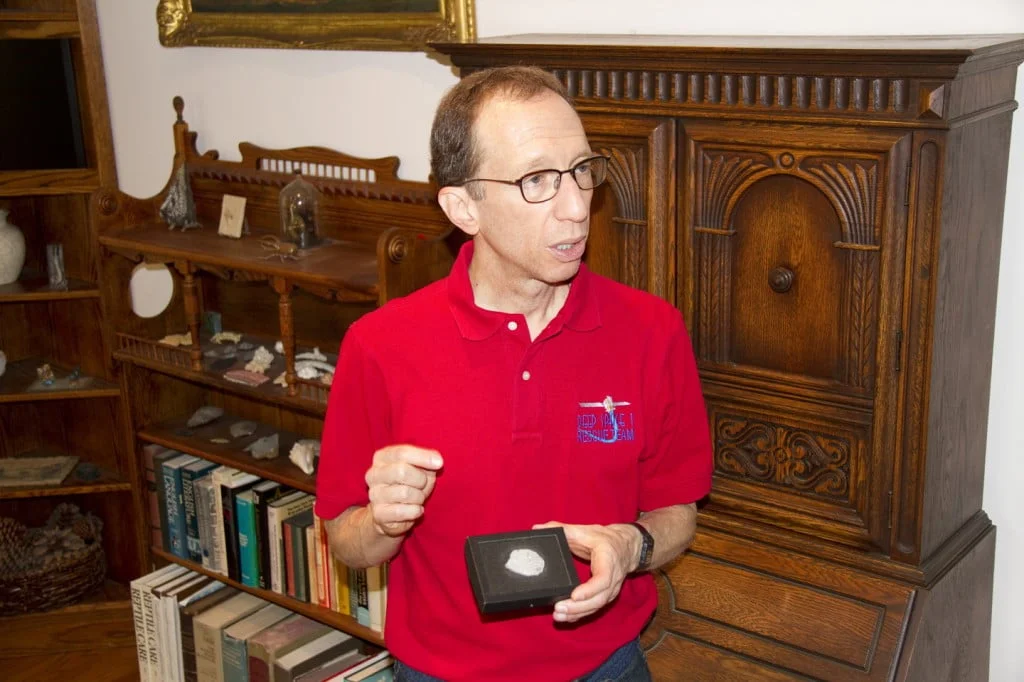
Rayman shares his piece of the sky- a meteor that hit Earth, traced to Vesta, second largest object in the asteroid belt, where his spacecraft was working.
By Mary O’KEEFE
Children are inspired by a variety of sources. It could be a teacher who handed them a special book or meeting someone larger than life or just peering into the night’s sky and thinking, “I wonder what’s out there.”
The latter has been inspirational, not only to those whose imagination has taken us to Mars, Saturn and beyond, but to those who turned the “what ifs” to “look at that.”
To get an idea of how science fiction and science work hand in hand, there’s no better place than the Jet Propulsion Laboratory.
Meet Marc Rayman.
He is the Dawn Project System Engineer at JPL. He has a Ph.D in physics and he is a science fiction fan.
“It’s a vast and wonderful cosmos,” Rayman said.
Rayman’s fascination with everything space began when he was a young boy, about 4 years old and he had a fear of witches. One night he saw a meteor fall from the sky and told his parents it was a witch.
“They said, ‘No, it was a shooting star’ and that really fascinated me. The idea that there was material out there coming down into our atmosphere and burning up,” he said.
And that started his fascination with everything science.
When he was 9, he began writing to cosmonauts in Russia, something that during the Cold War was a bit unusual, however Rayman believed in the “Star Trek” federation theory and that there was nothing wrong with the “bridge” looking like the United Nations.
“We are all on the same side in my view,” he said of scientists and engineers from all over the world.“[Science fiction] is a vision of the future that many people want to see,” he said.
Rayman was part of the Deep Space One team whose mission was to test high-risk technology on spacecraft. If it worked, the team would show in detail how well it did and how the technology could be used in other missions. If it didn’t work, they would find a way to make it succeed.
Deep Space One was launched in October 1998 for an 11 month mission through the solar system to test mission technology.
They used ion propulsion.
“The first time I heard of ion propulsion was in ‘Star Trek,’” Rayman said.
At that time, ion propulsion was not an actual science term, but Rayman knew that the term would resonate with science fiction fans. He also knew that connecting science fiction and science was a way to bring people into NASA and JPL.
“Every ‘Star Trek’ and every ‘Star Wars’ fan will know what [ion propulsion] is. This was the perfect way to help engage people out there that are science fiction fans just like me,” he recalled.
The initial Deep Space One mission was so successful the team requested a mission extension that was granted.
“Then we had a devastating failure with the spacecraft. It should have been fatal,” he said. “Everyone, including me, said it would be impossible to fly the spacecraft … but it is said if it isn’t impossible, it isn’t worth trying and I like the quote from a favorite movie: ‘Never give up. Never surrender.’”
The Deep Space One rescue team was formed and the spacecraft became operational again.
Rayman has a science fiction fan base but his true fandom comes from real science. He assures that although science fiction is fun to read and exercise the imagination, he said that real science is just as exciting.
This story originally was published online at
www.true-believer.net. For a complete version of the story, visit the website or go to cvweekly.com and click on True-Believer.
